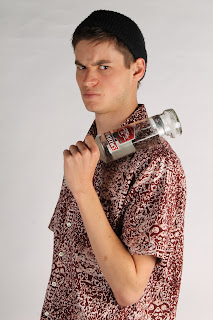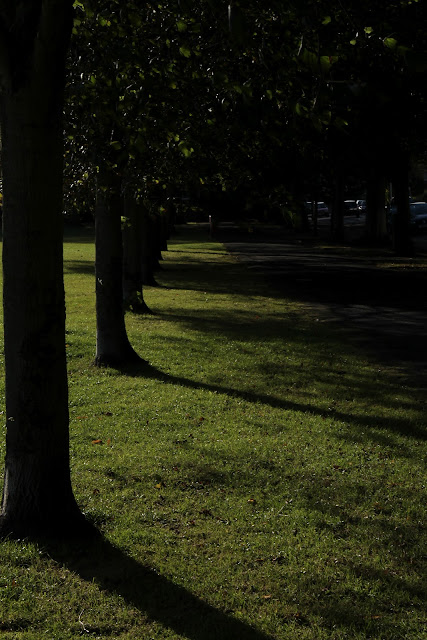For my photo shoot, I wanted to portray the sentence and meaning, 'A Bailed Up Bimbo - A messed up tough guy'. I chose to do this text first and interoperate into image because during college, my tutor wanted to divide our class into groups and luckily enough a young man was willing to be my model for this shoot. He is very tall and honestly not the most muscled guy, however it was good at the time that his tallness, was a challenge because to try and get the shot that I needed to get, I had to get to the same around height as him and this was very challenging. To conquer this challenge, I had to balance onto my toes so that I can be tall but making sure that the walls next to the back-drop wasn't showing within my images that I was taking. I was also facing a challenge of trying to get the angles right so that the angle of the image would not make my model look too overpowering but also not weak. I experimented with the angles, but as you can see within my contact sheet, you can see that I have stayed with the face on angle to give the image more unique but also simple at the same time. This image shows both height and angled challenges by the way that you can see the wall just above the model's head and above the back-drop and you can also see this image is a bit overpowering, due to the way that the bottle is a lot more higher up than the photographer.
 |
| Image that shows both my challenges |
Firstly I had to think about how I wanted my model to pose and how I wanted my images' meaning to come across exactly how I wanted them to become. After thinking for a while, I started to shot face on portrait shots, with my model to the side and body face on as well. However this posing wasn't going exactly how I planned, so I thought that by using a prop this might make the image more effective and more natural for my description of the sentence that I am trying to portray. I asked my model to act mysterious and as if he had something to hide from the photographer or someone who is walking towards him, but I also told him to look harsh in his face as if he is trying to toughen up and stick up for himself but overall he isn't succeeding to stick up for himself. So as you can also see on my contact sheet, that my model was moving around in different angels, standing to the side, standing face on and even standing to the side and not looking at the camera. Here are a couple of examples of different poses throughout this shoot:
 |
| Angled Pose |
 |
| Face-on Pose |
 |
| Side-on Pose |
Although I was concentrating on taking my images, my pupils, model and myself were all having a laugh and having fun all the way through this photo shoot, but whilst we were having a laugh, I suddenly came up with the idea of having his red shirt tucked underneath his grey t-shirt to try and make him look more 'muscularly' and 'tough'. I thought that I would do this, because it is soo obvious that due to the size of his arms compared to the 'muscled' shoulders this look does not look realistic or natural, however it does look some how hilarious once you know what is happening within the image and I hope that my viewers will be able to see this. I have chosen to have a bit of his shirt hanging out of his t-shirt so that you are pretty confused on what that object is hanging down his arm, but this brings the mysterious side of my models' personality across. I started shooting and one by one the images that I was capturing were getting better and better, I kept shooting until I got the shot that I could possibly get from this photo shoot and I knew that when I finally got that shot, I knew instantly that this whole idea of 1920's language slang was going to work how I wanted it to.
For this photo shoot, the sort of equipment that I used to create the best lighting that I possibly could to try and get the background as white as possible. I used:
- One 1100 D Canon camera.
- Two medium soft boxes.
- White back-drop
- Light Metre
For my image that I have chosen for my final piece, it's camera settings that I managed to fin by using a light metre were:
- Shutter Speed - 1/125
- Aperture - F 16
- ISO - 100
Here is my final image piece for my first title and meaning:
Overall, for this first photo shoot, I think that this shoot went really well because I faced many challenges along the way and I think that I conquered them without any hesitation, so due to this I didn't let these challenges phase me so I just kept going so that I was focused on getting the best shot that I could get.
The things that went really well through this photo shoot was that my model was very responsive when I needed him to move or to make him loosen up his look if he looked too stiff within the frame and this would make the image look uncomfortable, and I did not want this for my final piece. The lighting up the white background has come up really well, better than I had expected even though it looks grey in some parts, I feel that this helps to give the mysterious look through my image. By having a blank space on the left hand side, and my model on the right side of the frame, this creates a great layout for when I would be applying all of my text onto this image and if I wanted to enhance the image in any way. Lastly I like the way that my model in my final piece has positioned his arm, this makes the feeling of 'toughness' or if he is 'hiding' away from the audience and he is creating his own comfort. I like the was that just from my model's face, he just looks empty as if the emotions of himself had just been soaked up and thrown into a padlock and he doesn't want anybody to find the key because then he will become vulnerable.
If there was anything that I would change about this first photo shoot, would be that I would not have any shadows on the left side of his face. The reason for this is and there are shadowing is because the right medium soft box, was too closer to the model than the soft box to the left hand side of myself. This caused a lot of shadowing, but I thought deeper and I figured out that when I was measuring both of the lights with a light metre, I think that I made the right soft box a lot more brighter than the one on the left.
Overall my photo shoot went really well and I am soo pleased with my outcome for 'A Bailed Up Bimbo'. One reason for this is because I was having fun whilst shooting this shoot which I was intending to do and I will be intending to do throughout the rest of my shoots, two because y model did a fantastic job being well concentrated whilst being very confused on why I got him to put his shirt under his T-shirt and three because I managed to achieve a great outcome that I really like.
Photo shoot two:
For my second photo shoot, I wanted to portray the sentence and meaning 'A Flapper And A Giggle Water - A stylish, brash, hednostic young woman with short skirts and shorter hair'. For this shoot, I had to book out the studio and to start to become independant within myself so that I would get used to the feeling of using the studio by myself. My model that I was using for this shoot
For my second photo shoot, I wanted to portray the sentence and meaning 'A Flapper And A Giggle Water - A stylish, brash, hednostic young woman with short skirts and shorter hair'. For this shoot, I had to book out the studio and to start to become independant within myself so that I would get used to the feeling of using the studio by myself. My model that I was using for this shoot




























